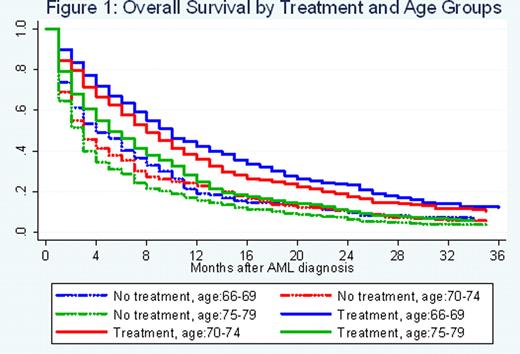Abstract
Abstract 3589
AML is the most common leukemia among US adults with median age of 69. Earlier 1990s studies reported a median OS was 2.4 months among patients older than age 65. Considering the trends in older AML treatment might have changed during the last decade, we investigated clinical practice for older AML patients.
Patients age ≥ 66 in the National Cancer Institute's (NCI) SEER cancer registry with a first, primary cancer of AML diagnosed between January 2000 and December 2007 were matched to their Medicare Part A and Part B claims for long-term follow-up. Diagnostic evaluation and treatment patterns with disease outcomes were assessed. There were 4633 AML patients identified, and 1791(38.6%) received intravenous leukemia therapy within 3 months of diagnosis (treatment group). Treated patients then were sub-grouped as receiving chemotherapy (chemo) (94.9%) and hypomethylating agents (hypo) (5.1%).
The median age of the study population was 78. Treatment group had similar demographics compared to the no treatment group except they were younger (median age, 74 vs. 80, p<0.01) and more were male (56.9 % vs. 48.8%, p<0.01). Median Charlson comorbidity score (CCS) were similar (median, 0) but less patients in treatment group had CCS ≥ 2 (13.0% vs. 20.1%, p<0.01). Patients in treatment group received more extensive diagnostic work-up including: flow cytometry (72.3% vs. 50.8%, p<0.01), cytogenetics (48% vs. 27.4%, p<0.01) and human leukocyte antigen (HLA) typing (6.8% vs. 0.6%, p<0.01).
Median OS was 3 months, but superior in the treatment group (7 mo. vs. 2 mo, p<0.01). This benefit was demonstrable in all age groups with greatest improvements in age 66–69 (10 mo. vs. 4 mo, p<0.01) and 70–74 (8 mo. vs. 3 mo, p<0.01) (Figure 1). Older age and CCS ≥2 were also associated with decreased OS (HR=1.04 (for each year), p<0.01 and HR=1.3, p<0.01 respectively). Within the treatment group, 2-month mortality after treatment was 31.2 % with the lowest level in age groups 66–69 and 70–74 (19.8 % and 25.2 %). Logistic regression analyses revealed that older age and CCS ≥2 were significantly associated with higher 2-month mortality (HR=1.08 (for each year), p<0.01 and HR=1.3, p<0.01 respectively).
Among treated patients, a subgroup analysis of 91 patients receiving hypo showed that they were older than chemo group (median age 78 vs. 74, p<0.01), but had similar CSS scores. Although OS with hypo was increased compared to chemo group (9 mo. vs. 6 mo.) in multivariate analysis this difference was not significant (HR=1.25, p=0.07).
Hematopoietic stem cell transplantation (HCT) was performed only in 57 patients (1.2%) after AML diagnosis. Median time to HCT after AML diagnosis was 6 months. These patients were younger (median age 66 vs. 73 in other treated patients) and none had CSS scores >2 (0% vs. 6.1%). Their median OS from diagnosis was 25 months.
Intravenous therapy improves OS in older AML patients and most patients up to 80 years of age should be considered for treatment based on their comorbidity status. New therapies including hypomethylating agents and allogeneic HCT are promising and must be compared with other chemotherapy in the appropriately selected population.
Weisdorf:Genzyme: Consultancy, Research Funding.
Author notes
Asterisk with author names denotes non-ASH members.


This feature is available to Subscribers Only
Sign In or Create an Account Close Modal